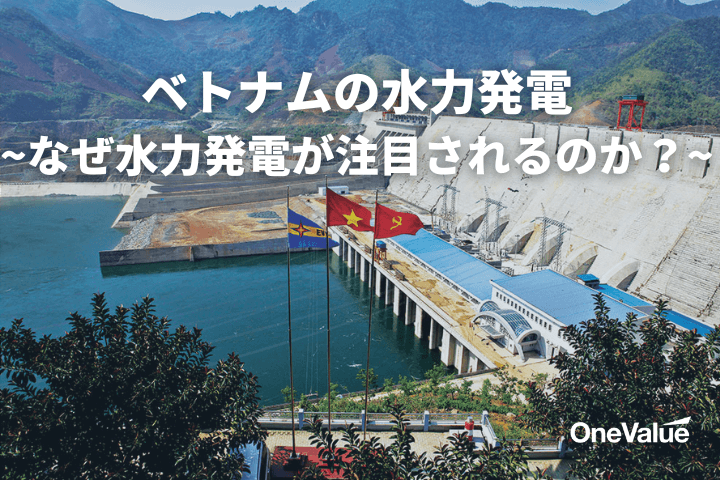- Introduction
- Overview of Hydropower in Vietnam
- Why is Vietnam’s Hydropower Generation Attracting Attention?
- Legal System for Hydroelectric Power Generation
- Vietnamese Government Policy
- Typical Hydroelectric Projects
- Issues Related to Hydropower Development in Vietnam
- Future Outlook in Hydroelectric Power Generation, Summary
Introduction
This page will provide a comprehensive overview of hydropower in Vietnam.
Overview of Hydropower in Vietnam
Vietnam has great potential for hydropower generation. Vietnam has a relatively high average annual rainfall of approximately 1,800 to 2,000 mm, and some of the terrain is suitable for hydropower generation. For example, 3/4 of the northwestern region is mountainous, with more than 3,450 water systems and dense river systems. Against this background, hydropower in Vietnam is promising, and hydropower has been developed in Vietnam for a long time.
As of 2022, hydropower will account for a certain share of Vietnam’s power supply mix, but it has yet to take advantage of the country’s water resources, and is expected to attract more attention in the future.
Definition of Hydroelectric Power Generation
Although the classification of hydropower projects varies from country to country, in Vietnam, they are defined by output (MW) as follows according to Decision No. 2394/QD-BCN issued by the Ministry of Industry (now Ministry of Commerce and Industry) on September 1, 2006.
- Medium and large hydropower plants: more than 30 MW
- Small hydropower plants: 1 MW to 30 MW
- Very small hydropower plants: less than 1 MW
Development Trend
This paragraph describes the past development and current status of hydropower in Vietnam.
Past Developments:
The first hydropower plant in Vietnam began construction in Lam Dong province in 1942; as of 2018, there were 385 CODed hydropower plants in Vietnam with a total installed capacity of 18,564 MW. The number of projects under construction is 143 with a total installed capacity of 1,848 MW. There are also 290 projects under study for investment, with a total capacity of 2,770 MW.
As of 2020, the total installed capacity of hydropower plants in operation in Vietnam will be 20,685 MW, accounting for 30% of Vietnam’s power supply mix.
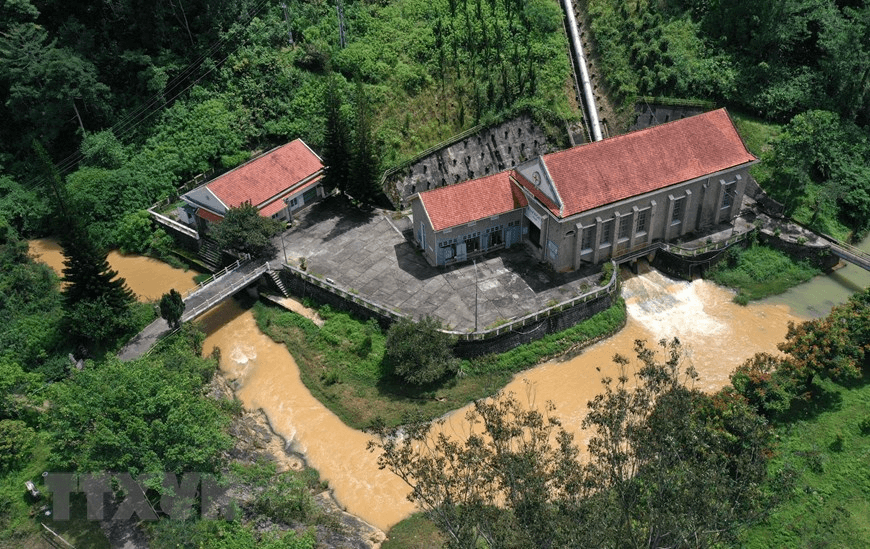
Future Development Plans (PDP8)
According to the draft PDP8 of the Ministry of Industry and Trade, the Vietnamese government is considering two energy development directions, the “Basic Scenario” and the “Energy Source Transformation Scenario,” and both plans promote hydropower development. According to the plan, the total installed capacity of hydropower across Vietnam is expected to increase to 26,795 MW by 2025, accounting for 27% of the power supply mix; by 2045, the total installed capacity of hydropower is targeted to reach 35,139 MW, accounting for 9 to 10% of the power supply mix.
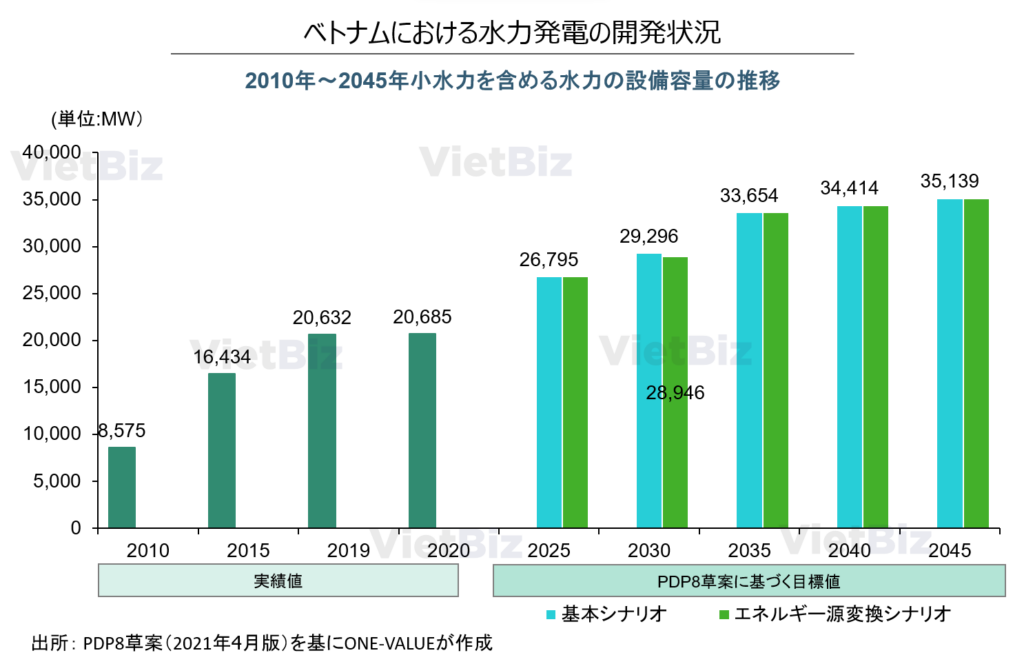
Specifically, hydropower is expected to be developed as follows
- Medium and large hydropower
According to the Ministry of Commerce and Industry’s draft PDP8 (April 2022 version), 34 medium and large hydropower projects will be developed during the 2021-2030 period, with the total installed capacity of new projects reaching 3,873.9 MW. 11 new projects (with a total installed capacity of 1,947 MW) will be constructed in the 2031-2045 period. (total installed capacity of 1,947 MW) are expected to be constructed in the period 2031-2045.
- small-scale hydraulic power generation
In the future, besides expanding existing medium- and large-scale hydropower plants, the Vietnamese government tends to develop small-scale hydropower as well, in order to fully utilize the potential of water resources.
The total installed capacity of small hydropower projects added to the national Master Plan has now reached 11,486 MW. Of this total, projects in the northern part of the country account for 65%, with a total installed capacity of 7,430 MW. This is followed by the North Central region, accounting for 17%, with a total installed capacity of 1,962 MW. Third is the Central Highlands region, accounting for 10%.
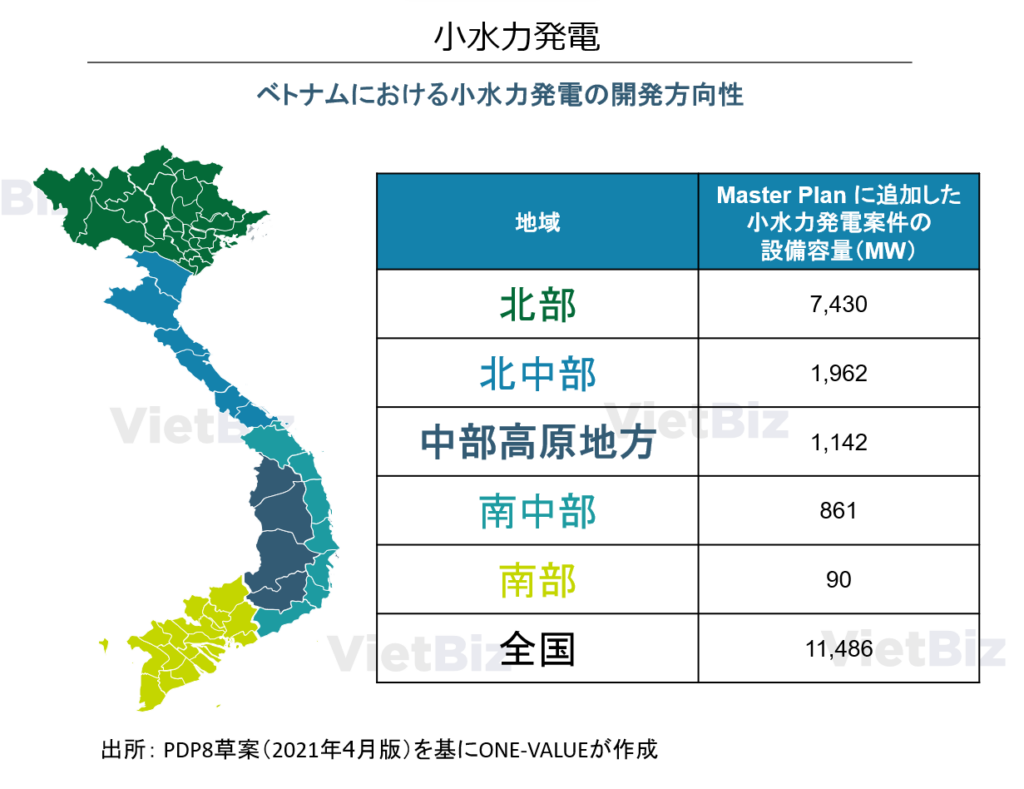
As of October 2020, there were 491 hydropower projects added to PDP8 in the North, representing 49% of the total installed capacity nationwide, or 13,720 MW; Thac Ba, Hoa Binh, Son La, Lai Chau, Huoi Quang, Ban Chat, and Tuyen Quang, There are 194 medium and small hydropower plants in operation, in addition to large hydropower plants such as Thac Ba, Hoa Binh, Son La, Lai Chau, Huoi Quang, Ban Chat, Tuyen Quang, and Nam Chien. The total installed capacity has reached 9,585 MW, accounting for 70% of the capacity added to PDP8. Hydropower plays a major role in the economic development of the northern provinces.
Why is Vietnam’s Hydropower Generation Attracting Attention?
This chapter will list the reasons why hydropower in Vietnam is attracting attention.
Many Water Resources (rain)
Vietnam has more than 100 watersheds and nearly 3,500 rivers with a total length exceeding 10 km. The average total annual volume of surface water is approximately 830 to 860 billion m3. Currently, the water used is about 81 billion m3, which is almost 10% of the average total water available. The total groundwater reserves in Vietnam are estimated to be about 63 billion m3/year.
Based on water resources, the total potential installed capacity of hydropower in Vietnam is theoretically about 35,000 MW. Of this, 60% is distributed in the north, 27% in the central region, and 13% in the south.
The technical potential (potentially developable) is about 26,000 MW, corresponding to about 970 planned projects, which are expected to produce more than 100 billion kWh/year. 970 projects include about 800 small hydropower plants with a total capacity of about 1.5 to 2 billion kWh/year. The total amount of electricity generated is expected to be approximately 1.5 to 2.0 billion kWh/year.
Small Hydroelectric Power Is One of The Renewable Energy Sources
Hydropower has the advantage of reducing GHG emissions and protecting the environment. GHG (greenhouse gas) emissions from hydropower are 1/25th of those from coal-fired power plants. As for small and medium-sized hydropower projects, the average land area required for construction is 1.9 ha / 1 MW, which is very small compared to the regulation of 10 ha/1 MW set by the Ministry of Commerce and Industry Circular No. 43/2012/TT-BCT.
Since the Vietnamese government has publicly stated “virtually zero GHG emissions by 2050” as a national goal, renewable energy sources, including hydropower, are expected to become more important in the future.
A Large Share of Vietnam’s Power Supply Mix
According to EVN (Electricity Generation Company of Vietnam), hydropower will account for 28.5% of Vietnam’s power supply mix in 2021, the second highest share after coal-fired power generation. In 2021, hydropower generation will amount to 78.605Mil KWh, or about 30.6% of the total generation of each power source.
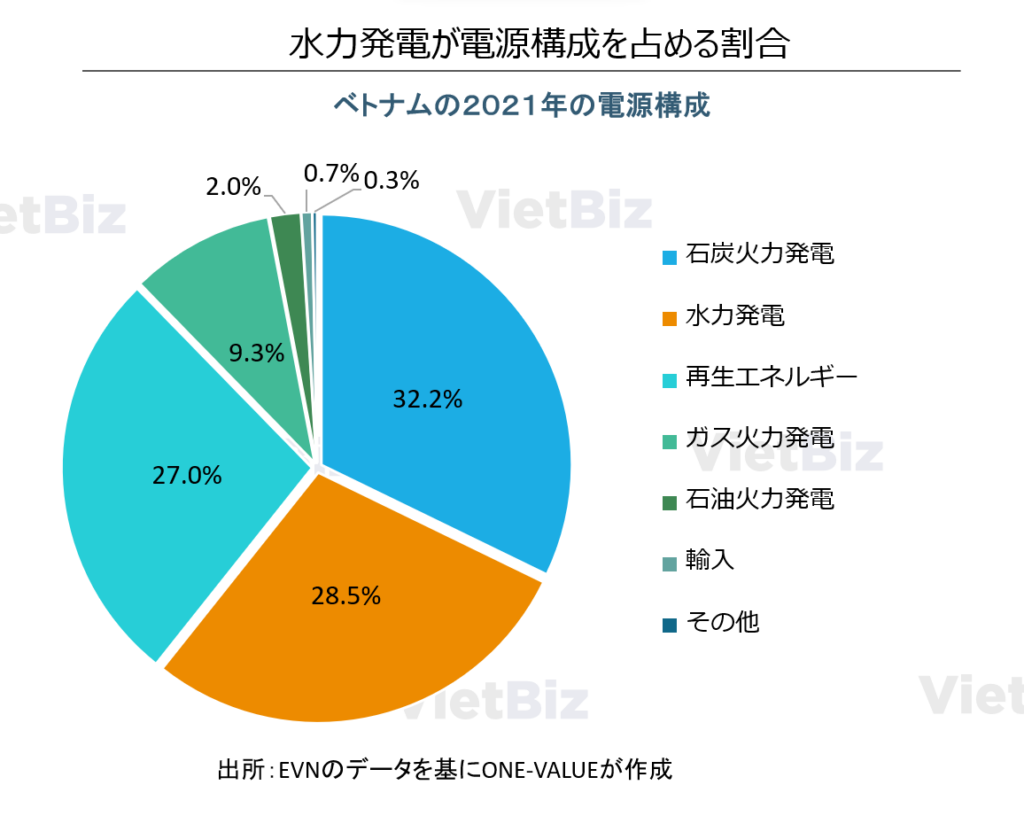
Electricity Demand Increasing in Vietnam
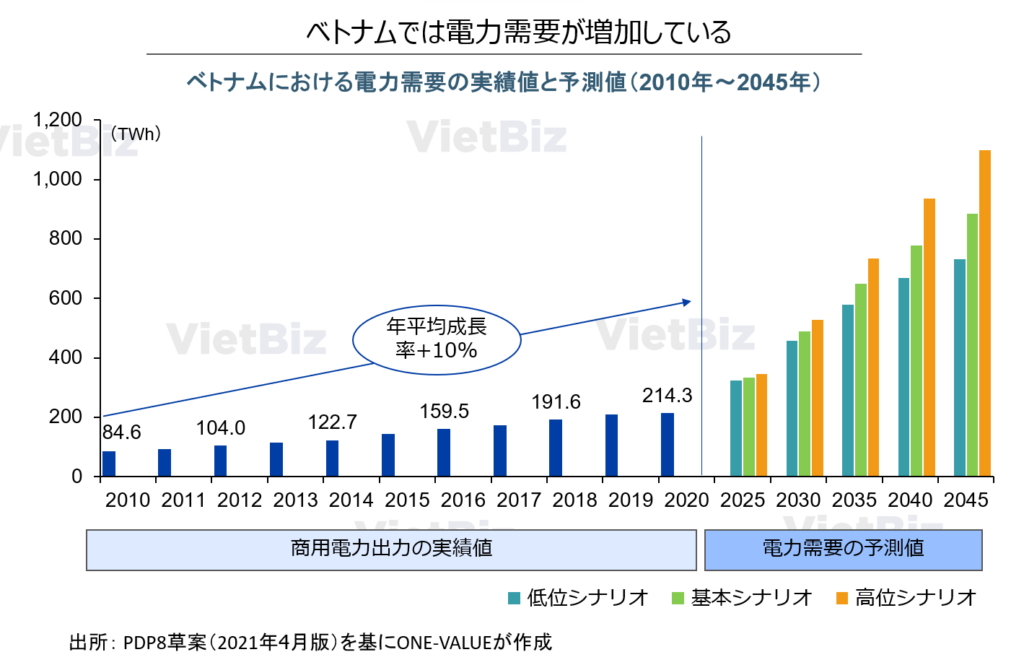
During the period 2010-2020, electricity demand in Vietnam has been increasing annually, with an average annual growth rate of 10%. Annual commercial electricity output increased from 84.6 TWh in 2010 to 214,3 TWh in 2020; by 2025, Vietnam’s national electricity demand is projected to reach 325-347 TWh and rise to 733-1,101 TWh by 2045.
Demand for electricity is growing rapidly with economic development, and in recent years the average annual growth rate of electricity demand in the North has exceeded 10%, with some areas growing by 15-20% In 2021, several provinces have very high load growth rates. For example, Hai Phong City has 15.8%, Thanh Hoa Province 13.59%, Hung Yen Province 11.3%, and Vinh Phuc Province 11.25%.
Small Hydropower Contributes to Economic Development
Small-scale hydropower plays an important role in socioeconomic development in many areas, especially in mountainous regions. Since the power transmission system is not well developed in the mountainous areas of Vietnam, many residents do not have access to electricity. The development of small hydropower plants can create opportunities for access to electricity for remote, isolated areas inhabited by ethnic minorities and rural areas that have not yet been reached by the national power grid system. Thus, through the development of small-scale hydropower in rural areas, the project is playing a role in securing lifelines in rural and mountainous areas of Vietnam.
No Dependence on Imported Fuels
The Russian-Ukrainian war that broke out in February 2022 has pushed up global oil and gas prices. Accompanying these increases have been increases in the prices of fuels such as coal, biomass fuels, and LNG. This has become a major problem for countries dependent on imported fuels.
Vietnam also needs to import some LNG and coal each year to meet the fuel demand of its operating power plants. The rising prices are expected to trigger the development of hydropower and other renewable energy sources in Vietnam to reduce the country’s dependence on imported fuels.
Legal System for Hydroelectric Power Generation
Every year, the Ministry of Industry and Trade of Vietnam issues a decision setting the upper limit of the price band for selling electricity to hydropower proposals On April 29, 2022, the Ministry of Industry and Trade issued Decision No. 820/QĐ-BCT, setting the upper limit of the price band for selling electricity to hydropower proposals in 2022 at VND1.110/kWh. That price is the same as in 2020 and much lower than the price for selling electricity from solar, wind and other sources.
Avoidable Cost
For small hydropower projects, the Ministry of Industry and Trade of Vietnam applies avoidable costs.
Calculated based on the avoided cost of producing 1 kWh from the highest production cost power system in the country, versus the cost of producing 1 kWh from the highest production cost power system in the country, if instead the power buyer purchased 1 kWh from a small hydroelectric power plant.
Avoidable costs for small hydropower during 2017-2022 (in VND/kWh)
| 2017 | 2018 | 2019 | 2020 | 2021 | 2022 |
| 2.242 | 2.306 | 2.306 | 1.932 | 1.932 | 1.932 |
Avoidable costs increased from 2017 to 2019, but have remained unchanged since decreasing in the following three years.
Vietnamese Government Policy
According to the draft PDP8, Vietnam is moving toward promoting new development of pumped storage power generation and hydropower on irrigation reservoirs in order to achieve carbon neutrality by 2050, as promised by the Prime Minister at the COP26 conference.
On the other hand, maximum use will be made of existing projects, especially for multipurpose hydropower projects. Nationwide, hydropower plants on irrigation reservoirs and low drop-off hydropower plants will be selected and developed on new land, small and medium size projects. Projects added to the PDP will continue to be developed.
Typical Hydroelectric Projects
This chapter will introduce some of Vietnam’s representative hydropower projects.
Solar Power Projects Led by Vietnamese Companies
Son La hydropower plant, the largest hydropower plant not only in Vietnam but also in Southeast Asia, was built on December 2, 2006 in It Ong Village, Muong La District, Son La Province, and is located on the Song Da River, the largest tributary of the Red River with a length of approximately 980 km The project was completed in 2012, three years ahead of schedule. Commercial operation began in 2012, three years ahead of schedule.
The reservoir of the Sonra Hydroelectric Power Plant has a storage capacity of 9.26 billion m3 and an area of 224 km2. The Sonra Hydroelectric Power Plant is a specially focused construction project, and even in the event of a magnitude 8 earthquake and a flood of 48,000 m3 / s occurring at the same time, the Sonra Hydroelectric Power Plant will remain safe. While supplying electricity, the Son La hydropower plant promotes the economic, cultural, and social development of the northwestern region, and also plays a role in regulating the water volume in the Red River Delta.
Sonra Hydroelectric Power Plant Basic Information:
- Project Name: Son La Hydroelectric Power Plant
- Location: Son La Province, Muong La District, It Ong Village
- Owner company: Electricity of Vietnam Corporation (EVN)
- Installed capacity: 2,400MW
- Average annual power generation: 9,429 Bil kWh
- Total investment amount: approx. 29 trillion yen (58,000Bil VND)
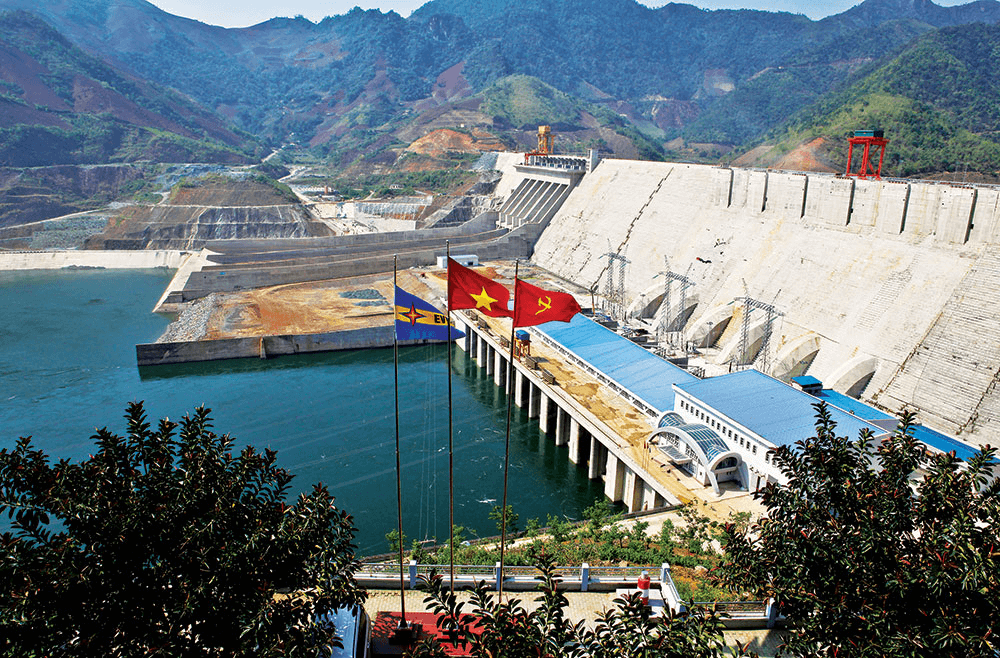
Photovoltaic Projects Involving Japan
Da Nhim Hydropower Plant is one of the oldest hydropower plants in Vietnam and is known as a prime example of cooperation with Japan. The Da Nhim hydropower plant exploited the water resources of the Dong Nai River and construction began in 1961 on the Don Duong Lake, and on January 15, 1964, Da Nhim Hydropower Plant officially put into operation Generators No. 1 and 2.
Each year, the Da Nhim hydropower plant supplies approximately 1 billion kWh, and in addition to supplying electricity, it provides water for domestic use and agricultural use for the delta region in Ninh Thuan province (an area of approximately 16,000 hectares).
Basic Information on Danim Hydroelectric Power Plant
| project name | Danim Hydroelectric Power Plant |
| location | Lam Son Village, Dong Duong District, Lam Dong Province |
| owner-managed enterprise | Da Nhim-Ham Thuan-Da Mi Corporation (a subsidiary of Electricity of Vietnam Corporation (EVN)) |
| facility capacity | 160MW(1964~2015) |
| Average annual power generation | Approx. 1 billion kWh |
With a grant from JICA, the expansion of the Danim Hydroelectric Power Plant began in 2015, with an expansion of the Danim Hydroelectric Power Plant to an installed capacity of 240 MW in 2018. The expansion of the Danim Hydroelectric Power Plant will continue and the installed capacity will reach 320 MW in 2026.

Issues Related to Hydropower Development in Vietnam
- Water resources are unevenly distributed among regions and over time. Sixty percent of the water volume is concentrated in the Mekong Delta region, while 40% is dispersed from the north to Ho Chi Minh City. In addition, the rainy season accounts for 70-80% of the annual water volume, while the rest of the year accounts for only 20-30%. The duration of the rainy season also differs among the northern, central, and southern regions, with the north beginning in July and August, and the central and southern regions lagging behind the north by several months. Northern Vietnam tends to have less precipitation from May to July, which reduces hydropower generation.
- Two-thirds of the water in Vietnam’s river basins comes from overseas. Recently, China, Laos, and other countries upstream of the river have constructed many hydropower projects, reducing the amount of water flowing into Vietnam. Dependence on upstream countries is emerging as a challenge.
- Water pollution is worsening in both degree and magnitude, especially in urban and industrial areas. Rising sea levels and saltwater intrusion due to climate change are also having a strong impact on water resources.
- There is a strong belief that suitable sites for hydropower generation have already been developed. New land is scarce.
- Few foreign companies have entered the hydropower industry.
Future Outlook in Hydroelectric Power Generation, Summary
Hydropower will continue to be an important source of electricity in Vietnam’s power structure. In addition to its role in power generation, hydropower plays many other significant roles for economic development and the environment, especially for an agricultural producer like Vietnam.
In the future, the Vietnamese government plans to develop hydropower projects under the following policies
- Small Hydropower: Small hydropower development will continue to be promoted, but will be carefully considered to ensure that it does not lead to water shortages, drought, loss of fish stocks, loss of alluvial deposits, flooding, or landslides. Furthermore, new projects are expected to be approved by the Ministry of Commerce and Industry, rather than by regional provincial-level People’s Committees as before.
- Expansion of the scale of large hydropower plants: Since most of the suitable sites for large hydropower plants have already been developed, the government is planning to expand the scale of existing projects by carefully selecting technologies. The draft PDP8 includes plans to expand large hydropower plants such as Lai Chau, Ialy, Hoa Binh, and Tri An.
- Pumped storage power generation: Currently, wind and solar power generation is growing rapidly in Vietnam, but the transmission system is still underdeveloped, so several projects are in a state of output curtailment. Therefore, the development of pumped storage power generation, which can produce power during peak hours and transmit it to the transmission system to make the power system more stable and avoid overloading, is being promoted in the future. 2020, the construction of Vietnam’s first pumped storage power plant will begin, and it is expected to be operational by 2028. according to the draft PDP8 According to the draft PDP8, four pumped storage power plants will be developed in Vietnam from 2021 to 2045, with a total installed capacity of 4,500 MW.
【関連記事】ベトナムの再生可能エネルギーと関連分野については、こちらの記事も合わせてご覧ください。
